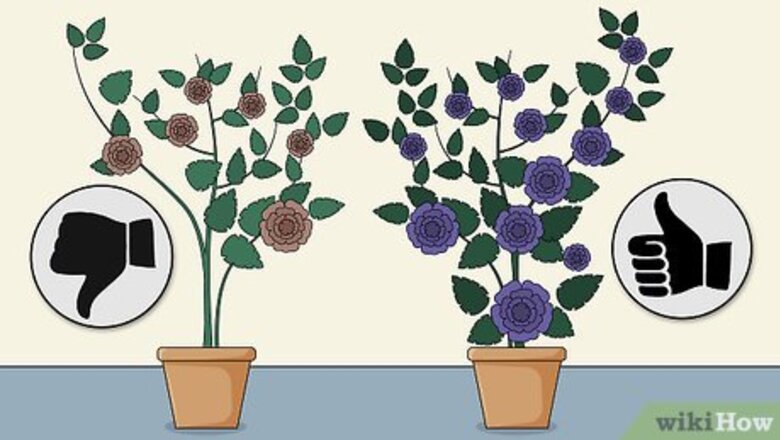
views
Planting Midnight Blue Roses
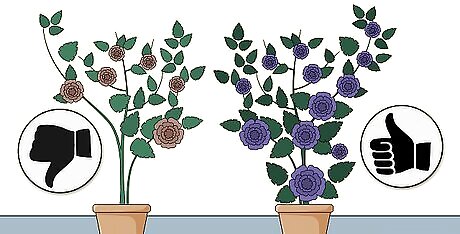
Pick out midnight blue roses that look healthy. Strong, healthy plants will be more resistant to diseases of all kinds, so the fight against rose disease starts at planting time. Select healthy rose plants that have sturdy-looking leaves and stems and don’t show any signs of disease or pests. Look to see if any of the leaves have black spots, red leaves, or chew marks. These are all signs of disease or infestation.
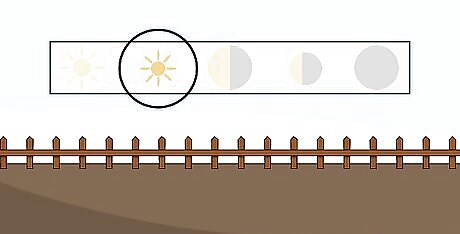
Select a sunny spot. Despite their name, Midnight Blue roses actually prefer sun to shade. They need about 6 hours of direct sunlight a day to be at their best, though they will still survive in very bright shade. Container rose bushes should receive a minimum of 4 hours of direct sunlight a day.
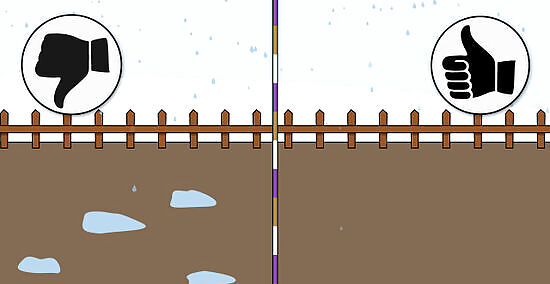
Choose a spot with well-draining soil. Roses have an easier time growing in soil that drains easily and does not hold water. Avoid planting them anywhere you’ve seen puddles form. Midnight Blue roses are not particular about soil type or pH, so there's no need to perform any soil tests.
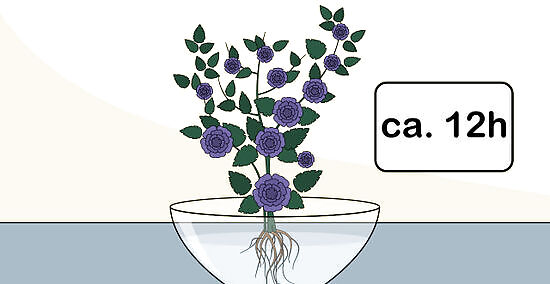
Soak bareroot rose bush roots overnight. If you’ve purchased a rose bush that isn’t in a container of soil, soak the roots overnight in a bucket of water. This will rehydrate the root system before you plant the bush.
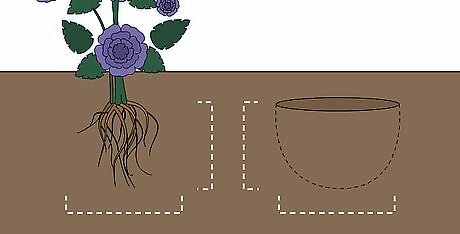
Dig a hole that will accommodate the bush’s roots. The hole needs to be wide enough and deep enough to hold the roots when they're all the way spread out. Aim for a size of about 2 feet (60 cm) wide and 2 feet (60 cm) deep. If you come across weeds or stones as you’re digging, use a garden fork to turn the soil over and remove them. Pull up anything that won't allow the roses’ roots to venture freely. If planting multiple shrubs, space them at least 2 to 3 feet (60 to 90 cm) apart to allow space for growth.
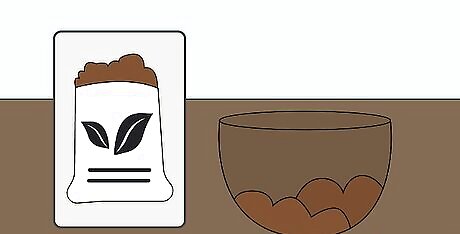
Add manure to the soil before planting your roses. Roses love soil that is enriched by manure, so incorporate some into the soil where you intend to plant your rose bush. You can purchase well-rotted manure at your local garden store. Be sure the manure is at least 3-4 years old, since new manure can burn the roots of roses. Try to incorporate roughly a bucket full of manure per square meter of soil. Alternatively, you can use decomposed compost instead of manure.
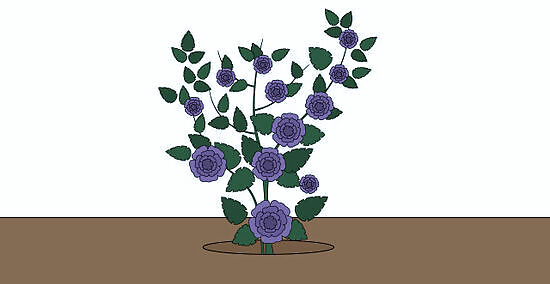
Place the bush in the hole and refill it with soil. The graft union, which is the little swollen area between the roots and the stems, should be at or just below the soil level. If it’s too high, you’ll need to dig the hole deeper. If it’s several inches below the soil line, add more soil and manure below the roots. Then spread the roots out in all different directions and refill the displaced soil. Placing a long stick across the top of the graft union will help you see if it’s level with the soil line before you begin to fill the hole back in.
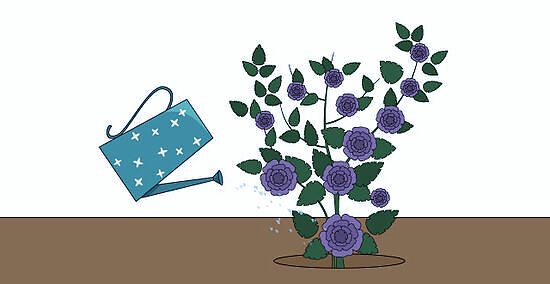
Water the rose bush and the soil around it. Saturate the area around the rose bush to remove any air pockets, settle the soil, and get water to the roots immediately. Stop when you see a puddle of water starting to form at the base of the plant.
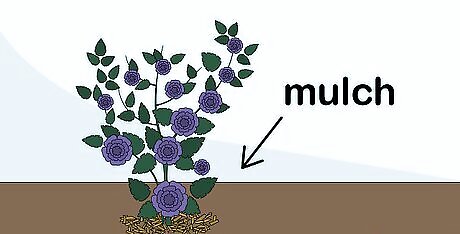
Apply a layer of mulch to the area to help fight weeds. Organic mulch should be spread over the dirt around a Midnight Blue rose bush to help retain moisture in the soil and keep weeds from growing. Apply a 2 to 3 inch (5 to 7 cm) layer, and maintain this level throughout the plant’s life. Use shredded bark mulch that has been properly processed to remove insects and diseases. Pre-packaged mulch that is sold at garden centers is the safest bet. It should state right on the bag that it has been composted or sterilized.
Watering and Feeding Your Roses
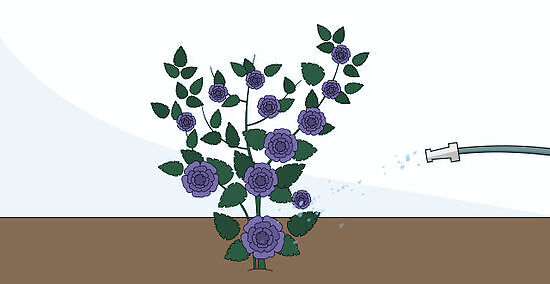
Water your rose bush when the soil around it becomes dry. To water your roses, wait until the top inch of soil is dry to the touch. Then give it a good, long soak to encourage your Midnight Blue rose bush to develop deep water-seeking roots that will help it survive drier periods in the future. In a hot, dry climate where temperatures rise to 80 or 90 °F (27 or 32 °C) or higher, your roses should be given 6 to 8 gallons (22 to 30 L) each week. You may need to water your roses every two or three days. In a more moderate climate, you will most likely find that you only need to water your rose bush once a week. Three to four gallons (11 to 15 L) should be sufficient. To prevent fungal growth, water in the morning to allow the leaves adequate time to dry out during the day.
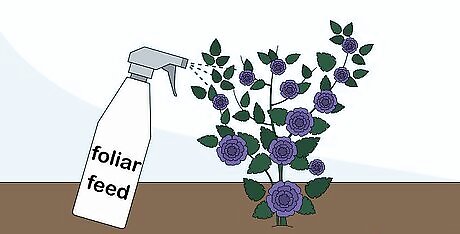
Apply foliar feed to the leaves. Foliar feed is a liquid plant food that is sprayed directly onto the leaves. In addition to providing the plant with nutrients, it also helps protect against disease. Begin feeding your Midnight Blue rose bush as soon as it’s established in the spring (about 3-4 weeks after planting, or as soon as you see new growth on an older plant). Feed it a couple more times during the growing season – once after the first blooms form and then a final time around midsummer. Water your rose bush before giving it fertilizer. Do not give fertilizer to a thirsty plant. Follow the dosage guidelines on the product packaging. Excess doses can damage the plant. You can opt to sprinkle a slow-release granule feed on top of the soil instead. The nutrients will be taken down to the roots the next few times you water the plant.
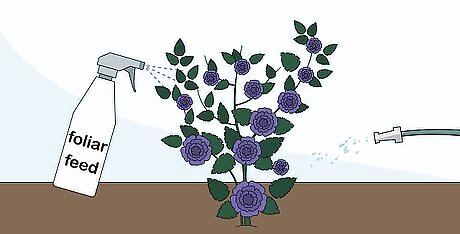
Feed and water a container rose bush more regularly. Give container roses a feeding every 2-3 weeks through the spring and summer with a foliar feed or granule feed. Check the top inch of soil for moisture several times a week, and if it feels dry, saturate the soil with water. Ensure good drainage by putting the container up on feet. A layer of gravel at the bottom of the container can also help with drainage. If the rose outgrows the container it will need to be repotted into a larger one. Look for matted roots at the surface of the soil or roots growing out through the drainage holes.

Pull weeds that grow up around your rose bush. Consider hand-pulling the weeds, as this is the gentlest and safest way to remove weeds without damaging your rose bush. You can also put mulch down around your plant to help stop weed growth. Try to avoid hoeing weeds around your roses, as rose roots tend to be close to the soil surface and can be damaged by the hoe. Avoid chemical weed killers as well, since these can also harm your rose bush.
Pruning Your Roses

Prune your rose bush in the early spring. Wait until the leaf buds begin to swell, then use a sturdy, sharp blade to ensure a clean cut. Prune by cutting at a 45-degree angle, just above an outer-facing growth bud. Growth buds are small raised or discolored triangular shaped areas on the rose stem. They are where the new stem will grow. Pruning above an outer-facing growth bud encourages the roses to grow outward, rather than inward, which can reduce air circulation and lessen the visual appeal of the bush. Avoid pruning your new rose for the first two years after you have planted it. Your rose bush will only need to be pruned after it has developed old growth or mature stems. If you wish to maintain the same size rose bush each year, trim back about ⅓ of the plant. If you want it smaller, trim more, and for a larger plant, trim less.
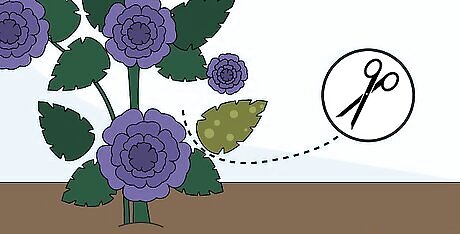
Remove any damaged or diseased growth. Cut this back until you see a healthy white center to the stem. Your aim is to have a plant where growth is well spaced out to encourage the flow and circulation of air. Remove close growing stems and any that cross or are tangled. On older plants you can cut back any old wood growth that no longer produces any new stems.

Prune in January if you live in an area with mild winters. In mild winter climates where shrub roses retain their leaves and bloom throughout most of the year, prune off all of the flowers and strip the leaves off the stems in January. When you do this, the shrub will be forced to take a brief rest and will grow fresh, new foliage and flowers in the spring.

Remove old flower heads to help the blooms last longer. One criticism of the Midnight Blue Rose is that the flower heads don’t last very long. To promote the growth of more flowers, remove the spent flower heads regularly during the flowering season. 'Deadheading,’ as this is called, will encourage the plant to produce more flowers rather than put its energies into producing seed heads (also known as hips). Only cut the spent flower heads back to the first leaf in order to preserve as many leaves on the bush as possible.

Remove any suckers that appear. Suckers are shoots produced from the plant’s roots. They appear from the ground and often have leaves that look different from the rest of the foliage: they may be paler in color or shaped differently. Trace any suckers back to the roots from which they grow and gently pull these away. If you just remove them at ground level they will regrow.
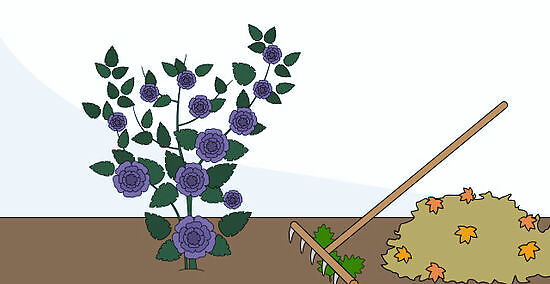
Rake up and dispose of any debris. Never leave any trimmed blooms, leaves, or stems on the ground around the bush. The debris can contribute to disease on your plant, so pick up all clippings and throw them away. Do not add them to compost since this could end up back in the soil around your rose bush.
Protecting Your Roses from Pests and Disease
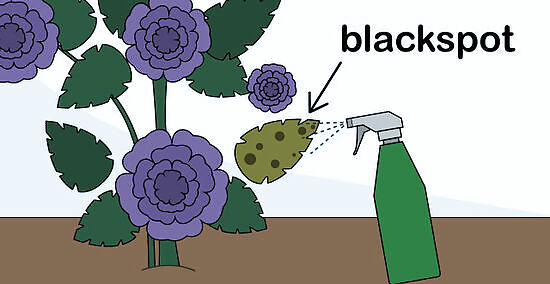
Treat blackspot with fungicide. Blackspot is a fungal disease that causes leaf loss and stunts plant growth. Left untreated, it can kill a plant. While Midnight Blue rose bushes are typically resistant to blackspot, large amounts of rainfall could still trigger an attack. To treat blackspot, spray the tops and bottoms of all leaves with a fungicidal spray. Remove any leaves or parts of the plant that are infected with blackspot and throw them away. Pruning to promote air circulation, only watering in the morning, and keeping the area below the plant free of debris are a few ways to keep the leaves dry and free of blackspot.
Pick off Japanese beetles and kill them with rubbing alcohol. Japanese beetles are small, green iridescent insects that damage blooms when the eat the rose buds and flowers. If you see these pests on your rose bushes, pick them off by hand. Then, submerge them in a solution of 1 part water and 1 part rubbing alcohol, or water with a little dish soap mixed into it. Alternatively, you could use a pesticide designed to kill Japanese beetles.
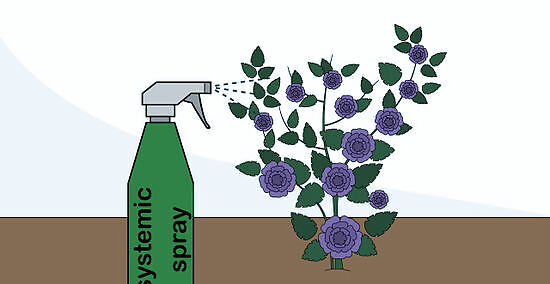
Prevent pests by using a systemic spray. A systemic spray will enter the plant’s system and prevent pests from being attracted to your rose bush. Use this once early in the growing season, just as leaves are beginning to form, then reapply every few weeks.
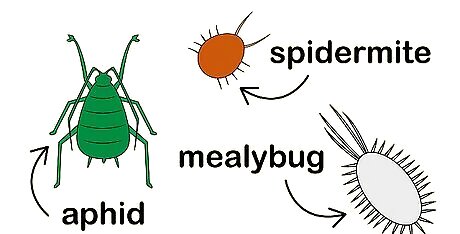
Check your rose plant for pests regularly. Inspect your rose plant regularly for signs of aphids, scales and mealybugs, and spider mites. Aphids are tiny, soft-bodied insects that are commonly green or white and look like miniature moths. Scales and mealy bugs are small, flat or rounded insects that are usually immobile and look like tiny cotton balls. Spider mites are barely visible to the naked eye, but they cause tiny dots or stippling on the leaves and a fine web between the leaves or branches.
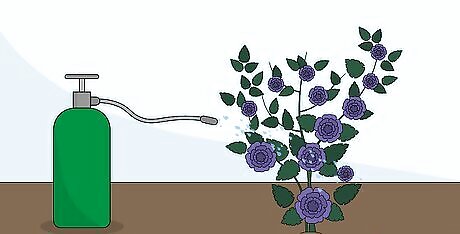
Spray an infested shrub with insecticidal soap. A mild infestation can usually be controlled by simply spraying them off with a strong stream of water from the garden hose in the morning a few times each week. However, if the pests become a serious problem, spray the rose in the early morning with insecticidal soap, being careful to coat the tops and bottoms of the leaves as well as the stems. This type of soap is commonly sold in ready-to-use form and comes in a spray bottle at garden or home improvement stores. Spray the entire shrub and stems until the liquid is dripping from the leaves and running down the stems. Wait about an hour, then wash it off with a stream of water.

















Comments
0 comment